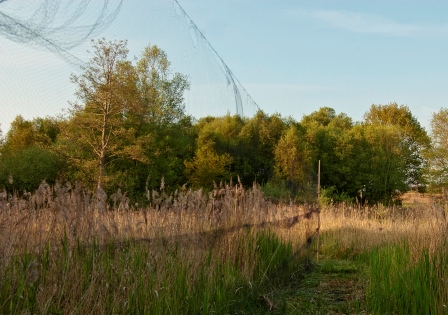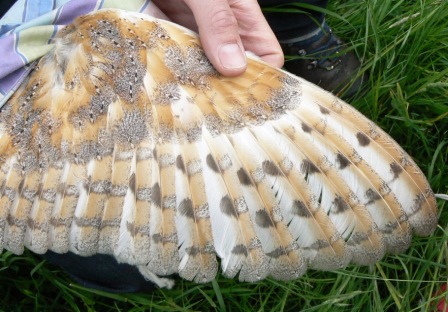A bird in the hand: why bird ringing is still so important.

By Ruth Walker, Ringing Surveys Organiser, BTO

It is 6:30 on a cold winter morning. Twenty bird ringers are lying behind a sea wall, waiting. A flock of waders walk up the beach ahead of the rising tide and settle in front of a line of nets. As day breaks, a voice over the radio counts down: ‘3, 2, 1…fire’. With adrenaline pumping, we run to the nets and carefully extract the birds before settling down to ring them. These birds are part of a 50+ year study of the waders that use the Wash Estuary on the east coast of England.
It is a common misconception that the main purpose of ringing birds is to see where migrant species spend their winters. Undoubtedly, this was the main reason the Ringing Scheme was set up over 100 years ago; it hadn’t been that long since people stopped believing that Swallows spent the winter at the bottom of ponds after all! These days we have all manner of tracking devices that can remotely follow birds throughout their migratory journeys to reveal their secrets, as has been shown so successfully by projects such as the BTO’s Cuckoo tracking project (www.bto.org/cuckoos). One bird with a tracking device can tell us a lot about that individual; where it goes, by what route, how fast it flies and so on. But what does the information from the one million birds ringed each year by the 3,000 volunteer bird ringers in Britain & Ireland tell us?

Ringing data make a major contribution to the study of population changes and to our understanding of species declines. Essentially, bird populations are determined by the number of fledglings raised and the survival of both juveniles and adults. Whilst ringers collect data on survival, volunteers for the Nest Record Scheme (a lot of whom are also ringers) collect information on productivity. The results can be analysed in combination with population trend data, such as that collected through the BTO/JNCC/RSPB Breeding Bird Survey, to determine at which stage of a bird’s life cycle there might be a problem (www.bto.org/birdtrends). This enables scientists and conservationists to target appropriate mitigation measures; for example, it would be ineffective to improve breeding habitat for a species if their decline is caused by lack of food in winter.
Information on survival is generated by re-encountering ringed birds. By using colour rings or uniquely inscribed flags, birds can be re-encountered without needing to be recaptured, which enables non-ringers to contribute to ringing projects by reporting sightings (www.ring.ac); reports of dead ringed birds are extremely valuable too! And by using PIT (Passive Integrated Transponder) tags fitted to a ring (similar to a chip in a cat or dog) a bird’s presence can be recorded automatically by a receiver.

Following the survival of individual birds is a particular focus for ringers taking part in the Retrapping Adults for Survival (RAS) Scheme. On an annual basis, each participant monitors adults of a particular species during the breeding season (when birds are more likely to be site faithful). When combined nationally, survival rate trends can be produced for each species being studied. Standardising ringing effort can also increase the chances of a bird being recaught. This is where the Constant Effort Sites (CES) Scheme comes in. Ringers catch birds in the same location, for the same length of time across the same range of dates each year; as catching effort is constant, we can be confident that any changes in the number of birds caught reflect true changes in abundance. Again, when data for all sites are combined, we can produce national and regional trends for abundance, productivity and survival (juvenile and adult) for the 24 species that CES focuses on.
Ringing isn’t only about survival though. Changes in species composition or abundance at a site level can alert land managers to potential problems with the habitat or inform management decisions. By ringing chicks, we are able to determine where they disperse to and by ringing at bird observatories, we can record the timing of spring and autumn migration. This can help to determine how well species can adapt to new situations, such as the effects of climate change. And it isn’t just declining species that need monitoring. As we don’t know which species may struggle in the future, it is crucial to collect baseline data for even the most common of species; back in the 1970s, no-one would have predicted the catastrophic decline of the (then) abundant House Sparrow, for example.

Bird welfare is always paramount so we try to minimise the amount of time a bird is in the hand, whilst at the same time maximising the amount of information we gather from each bird we handle. As well as fitting a ring, we collect biometric data such as wing length, weight, age and sex (where possible) and information on whether the bird is breeding (by looking for physiological indicators), moulting (by looking for missing or part grown feathers) or preparing for migration (by looking at the amount of fat it is carrying). For some species, such as the waders mentioned at the start, we might also measure the length of the bill and the tarsus (leg) and toe. This information can help to sex individuals in species where males and females are morphologically indistinct or allocate an individual to a particular race. It also provides general information about a bird’s physical condition; for instance, to conserve energy when food resources are low, birds can stop moulting part way through the process, resulting in feathers of noticeably different ages.
There are no formal qualifications needed to become a bird ringer, although you would be expected to be able to identify most common species. Training requires time and real commitment though; it normally takes around two years of ringing most weeks to reach the standard needed to allow you to operate mist nets by yourself. It is also not a cheap hobby. Although the Ringing Scheme is part-funded by the Government (through JNCC on behalf of the country agencies) and the BTO itself, ringers pay for all their own rings and equipment.
As well as bringing real benefits to science and conservation, ringing is fun and a privilege. I have been ringing for seven years and it has taken me to some amazing places, such as remote Scottish islands to ring seabirds. It also led me to the BTO where (amongst other things) I now run the CES and RAS schemes. For more information, visit: www.bto.org/ringing